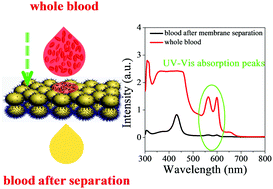Mineralized growth of Janus membrane with asymmetric wetting property for fast separation of a trace of blood†
Abstract
Separation of plasma from whole blood is requisite for the accurate measurement of glucose levels. From the wettability point of view, in this study, we report the fabrication of a mineralized Janus membrane with an asymmetric wetting property; this membrane can transport fast microliter-quantity blood and separate out the red blood cells. The membrane is composed of a hydroxyapatite (HAP)-mineralized polyvinylidene fluoride (PVDF) membrane prepared via an interface diffusion-controlled chemical precipitation method. Due to gradient distribution of the HAP nanocrystals across the PVDF membrane, the composite membrane exhibits an asymmetric wetting property where a tiny whole blood droplet (13 μL) can spontaneously permeate across the membrane within 20 s and red blood cells in the whole blood are successfully blocked by the membrane. The membrane is then integrated into blood glucometers for accurate measurements of the glucose levels. The results show that the porous membrane can successfully prevent red blood cells in whole blood from entering the enzyme layer; moreover, the negative effect of hematocrit levels on the blood glucose measurements is effectively minimized and an obviously high and stable glucose current signal is achieved.



 Please wait while we load your content...
Please wait while we load your content...